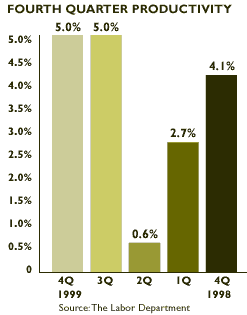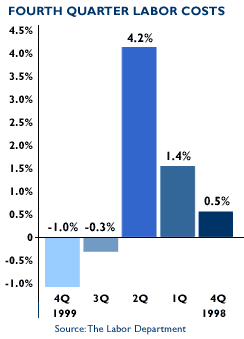|
Productivity surges in 4Q
|
 |
February 8, 2000: 11:51 a.m. ET
Worker productivity grows at fastest pace in seven years; labor costs slide
By Staff Writer M. Corey Goldman
|
NEW YORK (CNNfn) - U.S. worker productivity surged in the fourth quarter and wage costs posted their biggest contraction in nearly four years, finishing off a decade where work force efficiency helped propel the U.S. economy toward its longest uninterrupted expansion ever.
Productivity jumped 5 percent in the fourth quarter, the Labor Department reported Tuesday, well above the 4 percent increase analysts had anticipated and matching a revised third quarter figure. Labor costs -- a measure of what companies spend on worker output -- fell 1 percent during the October to December period, far greater than forecasts of a 0.2 percent decline and above the 0.3 percent contraction posted in the third quarter.
The numbers confirmed for analysts and investors that massive strides in technology -- everything from faster and better computer chips to automated assembly lines to the ever-expanding use of the Internet -- is allowing people to work more efficiently and providing companies with the ability to streamline their operations, thereby reducing costs and keeping a lid on prices. The report also quickly revived a term Wall Street pundits have grown fond of: The New Economy.
The numbers "fit perfectly with the so-called 'New Paradigm' view -- strong productivity growth keeps inflation pressure at bay," said Sherry Cooper, chief economist of brokerage firm Nesbitt Burns Inc. "This is a remarkable performance for an economy in its ninth year of expansion."
Lets get productive
The productivity gain was the biggest since a 7.4 percent jump in the fourth quarter of 1992, while the decline in unit labor costs was the largest since a 1.4 percent drop in the first quarter of 1996. For the year, productivity gained 2.9 percent, slightly above 1998's 2.8 percent, while labor costs rose 1.8 percent, down from a 2.4 percent increase a year earlier.
Productivity in manufacturing, which has been recovering from a slump in 1997 and 1998 caused by economic weakness in Asia and elsewhere, rose 6.4 percent in 1999 -- the fastest gain since a 6.9 percent gain in 1971.

Peter Morici, a senior fellow with the Economic Strategy Institute in Washington, told CNNfn's Before Hours that, because companies are able to get more and more output from their workers and keep expenses in line, they aren't being forced to pass on higher costs to consumers in the form of price increases. That means the white-hot U.S. labor market isn't posing a threat to the economic expansion, he said. (334KB WAV) (334KB AIFF)
Indeed, the Labor Department Friday reported that the economy generated 387,000 new jobs last month, the fastest pace in more than two years, while the jobless rate edged down to 4 percent, its lowest in a generation. Those numbers followed a report a week earlier showing the U.S. economy grew at 5.8 percent in the fourth quarter, its best performance of the year.
"These are spectacular numbers and confirm that the labor market is not at the moment the source of anything that could be plausibly described as inflationary pressure," said Ian Shepherdson, chief U.S. economist with market analysis firm High Frequency Economics.
Go GM go
So what are companies doing to keep prices from rising?
Take General Motors Corp. (GM: Research, Estimates). Throughout the 1990s the world's biggest automaker has been using technology to speed up automation of cars and trucks, and more recently it has delved into a business-to-business model of Internet commerce to get the lowest prices from parts suppliers. Other automakers including DaimlerChrysler (DCX: Research, Estimates) and Ford (F: Research, Estimates) are pursuing similar strategies.
International Business Machines (IBM: Research, Estimates) is another example. The world's biggest computer maker earlier this week unveiled a super computer chip that runs five times as fast as its competitors' products. It's also working on a new supercomputer code-named "Blue Gene."
Even e-commerce companies are getting faster and more efficient at taking orders for goods and getting them out to consumers -- without boosting their operating expenses and passing those costs on to consumers.
Amazon.com (AMZN: Research, Estimates), the world's biggest online retailer, last week posted a fourth-quarter loss, although it assured analysts and investors that it is working hard at boosting its productivity and profitability.
And investors wasted no time bidding up shares on those companies and others, propelling the tech-heavy Nasdaq composite index into record territory Tuesday and pushing the more traditional Dow Jones industrial average higher. Bonds also benefited from the strong numbers.
A cautious Fed
It all points to the New Paradigm theory that a growing number of economists and investors have been wary to accept -- that the U.S. economy, now in its record 107th month of expansion, is being spurred by strong productivity gains that are making companies and workers more efficient.
Federal Reserve Chairman Alan Greenspan has been one of many advocates of that theory, suggesting in speeches and testimony in recent months that productivity gains have pushed the U.S. economy into an era of growth without inflation, similar in nature to the Industrial Revolution of the 1800s.

At the same time, the Fed chief, along with many other market watchers, has been loath to reject the old-school notion that prices eventually will rise. That's why he and his colleagues raised interest rates last week -- the fourth quarter-point move in less than eight months -- and are expected to move again by another quarter point at their March 21 meeting.
The numbers "are clearly good news for the Fed," said Steven Wood, an economist with Banc of America Securities in San Francisco. "Strong productivity numbers raise the economy's speed limit and dampen inflationary pressures, lessening the magnitude of the rate increases that the Fed would have to implement. The key question, however, is: what level of productivity growth is reasonable to assume for the future?"
Either way, there's little question that productivity is significantly higher. After resting around the 1 percent level in the 1970s and 1980s, U.S. productivity growth has remained above 2 percent throughout most of 1990s. 
|
|
|
|
|
 |

|

